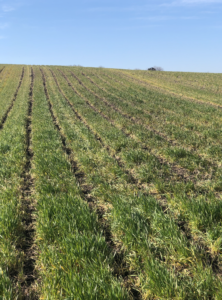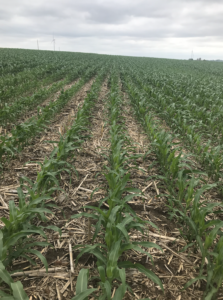
Berget Family Farms consist of Mike Berget, Matt Berget and Meghan Saunders and their families that farm 8,600 acres of corn annually, along with 2,200 acres of soybeans and 300 of wheat.
All corn-on-corn ground is either no-till or stripe tilled, except for heavy black river bottom ground is tilled. No-till practices are used on the soybean ground. We use split nitrogen applications. All our field work is done with state-of-the-art guidance systems with all field boundaries and waterways marked out. Any waterways or drainage ditches that need to be fixed or implemented we have our own equipment to do them ourselves. We pride ourselves on being good stewards of the land and keeping the land intact for many years to come.
1) How has being a member of LASA helped you accomplish your conservation goals?
Through meetings, field days and test plots that LASA hosts, I have learned new and better ways to raise cover crops.
2) What was the biggest challenge you faced with implementing a conservation practice?
The biggest challenge I’ve faced is having the time to do it and the resources.
3) Was there anyone who has helped you along your conservation journey? If so, who, and what did they do?
Josh Kamps has been great in helping us implement cover crops. He put a test plot in one of our fields, which I helped implement, and it opened our eyes to many new ways to use cover crops.
4) What is your advice to someone who wants to try a new practice but isn’t sure where to start?
I would suggest talking to Josh Kamps and having him put a small test plot on your farm to get started and see what would work best for your farm.
5) Were there any unanticipated outcomes from any of the practices you’ve tried?
I was surprised that we got as much nutrient uptake by oats over our old cover crop plant of Rye.
6) What surprised you the most after you tried planting into green for the first time?
With having a very dry spring and summer in 2021, I was expecting more crop stress because of the water use that the cover crop would have used before we terminated it in late June. To my surprise, the yield was as good if not better than the planted green fields.
7) How long have you been implementing conservation practices on your land and why did you start?
We started no-tilling about 20 years ago. We also started strip till practices 10 years ago. The biggest reason we started these practices was to save labor, fuel cost and time getting the crop in a shorter amount of time. The unexpected benefit we have seen since our fields have been with these practices for 10-20 year is the water capacity holding benefit, especially on a dry year like we have had.
8) How has LASA helped you understand conservation practices?
LASA has helped me understand through field days and annual meetings with exceptional speakers. It has opened our eyes to new practices that we have implemented and have helped us accomplish our conservation goals.
9) Why is it important for you to have a sustainable farm?
It is important to us that we practice sustainable farming because we rent a large portion of our ground and it shows the landlords that we intend to conserve their soil so that future generations will have the same benefits of the farm as they have.


